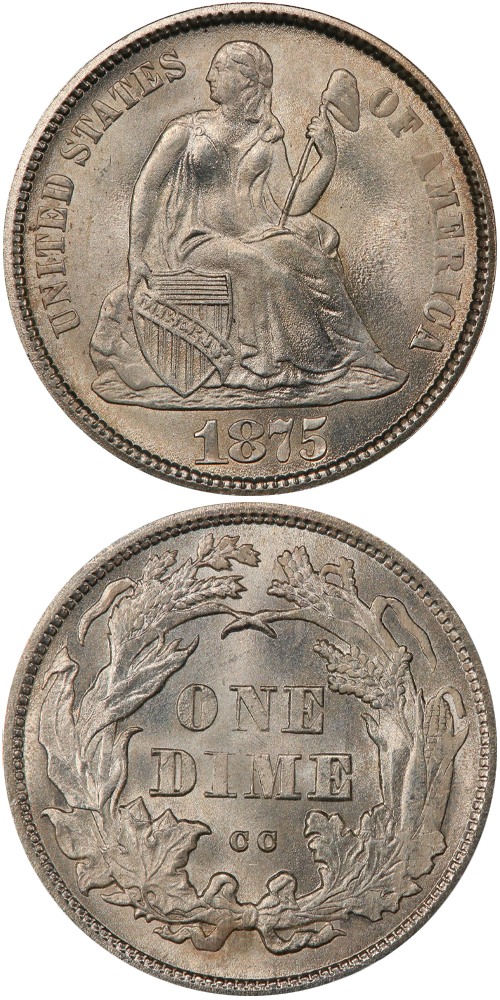1875-CC Liberty Seated Dime
Mintmark Above Bow
Jeff Ambio: A prominent obverse die dot (as struck) on Liberty's midsection is the most readily evident diagnostic of the Fortin-112 variety. On the reverse the CC mintmark is small and widely spaced.
Rusty Goe: Beginning in January 1875, the U.S. government embarked on a two-fold plan designed to restore confidence in the nation's monetary system, retire the fractional paper-money notes that had been introduced to subdue the small-change shortage in the 1860s, and to support the sinking silver market. The Treasury bought over $10 million worth of the white metal from mining companies in 1875 alone. The three mints in operation, Philadelphia, San Francisco, and Carson City, began stockpiling massive hoards of half dollars, quarters, and dimes. They added twenty-cent pieces to the mix midway through 1875.
The subsidiary silver coins being mass produced at the mints were absorbing some of the seemingly endless supply of the precious metal streaming out of the nation's mines. The "Big Bonanza" as they called it, hit simultaneously as legislators hammered out details of the Specie Resumption Act of 1875.
Coiner W. Hy Doane began using newly designed dime dies in February 1875. The "cereal" wreath design depicting corn, wheat, maple, and oak leaves on the reverse had replaced the "bowed-ribbon" design, with leaves and open-ended buds on the previous design back in 1860. The U.S. Mint had also relocated the legend, UNITED STATES OF AMERICA, to the obverse, replacing the 13 stars surrounding Ms. Liberty. Prior to those design changes, the mintmarks had always appeared directly under the word DIME on the reverse, just above the bowed-ribbon. Beginning in 1860, the U.S. Mint moved the mintmark below the new wreath design.
It is unclear why in 1875 the Treasury Department decided to shift the mintmark for San Francisco and Carson City issued dimes back to the approximate place it had been pre-1860. Whatever the reason, the experimental reverse die lasted only part way through the year. Before the government replaced it, however, with the old, standard Mintmark Below Bow version, millions of the Mintmark Above Bow dimes were struck.
In July 1875, Superintendent Crawford replaced Doane with a new coiner, Levi Dague. Director Linderman initiated the personnel change.
From the survival estimates, you can see that collectors should not find it difficult to obtain an 1875-CC Mintmark Above Bow dime, so long as condition is not a factor. I believe that my estimate of from one-eighth to one-fifth of one percent of the original mintage figure for 1875-CC Mintmark Above Bow dimes is reasonable.
Q. David Bowers: Two reverse varieties were made. The division of the mintages is not known, but it seems likely that perhaps 75 percent, give or take, were of the Mintmark Above Bow variety, as here, and 25 percent were of the Mintmark Below Bow. Choice specimens are readily available. Mint State coins are typically very attractive.
Varieties occur on this high mintage date, the most obvious being the mintmark CC quite widely spaced and another style with the letters close together.
The example to the left was sold by Stack's Bowers Galleries in the August 2020 Showcase Auction, where it realized $26,400.






